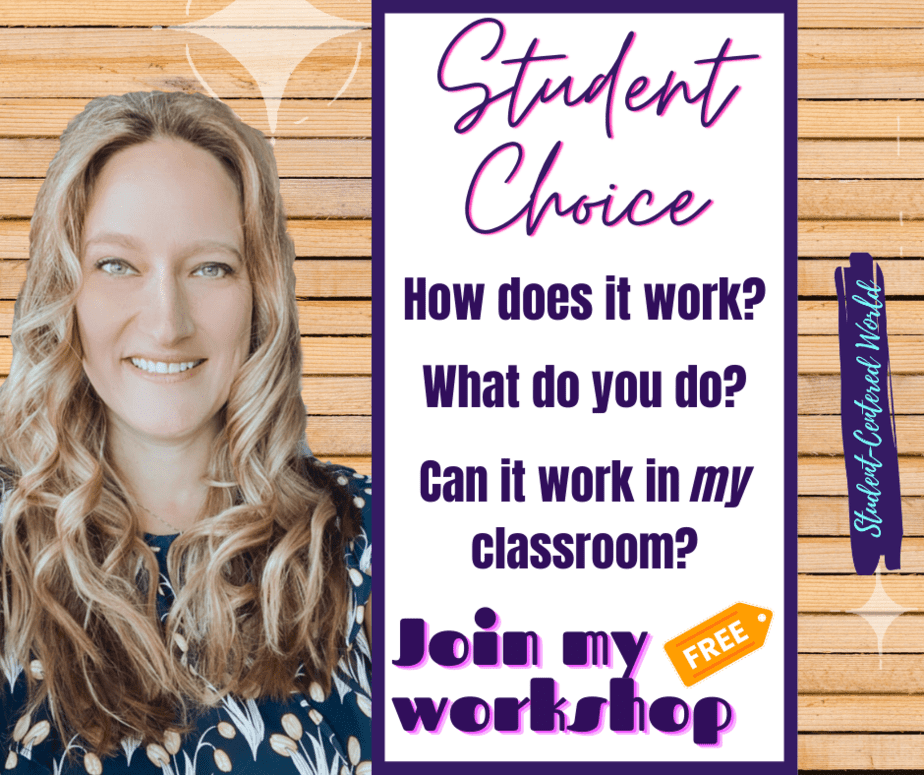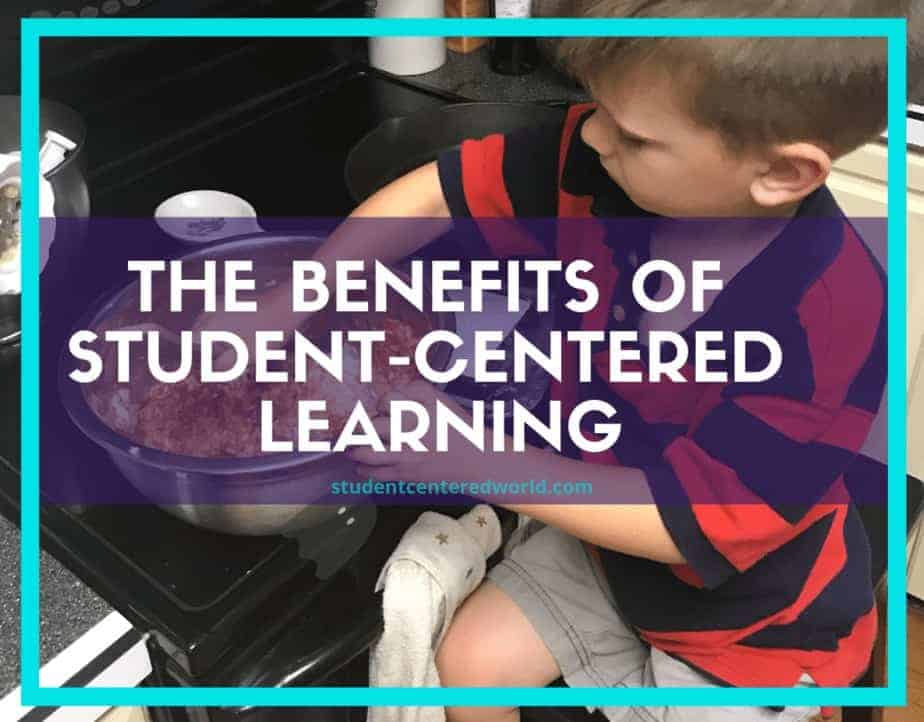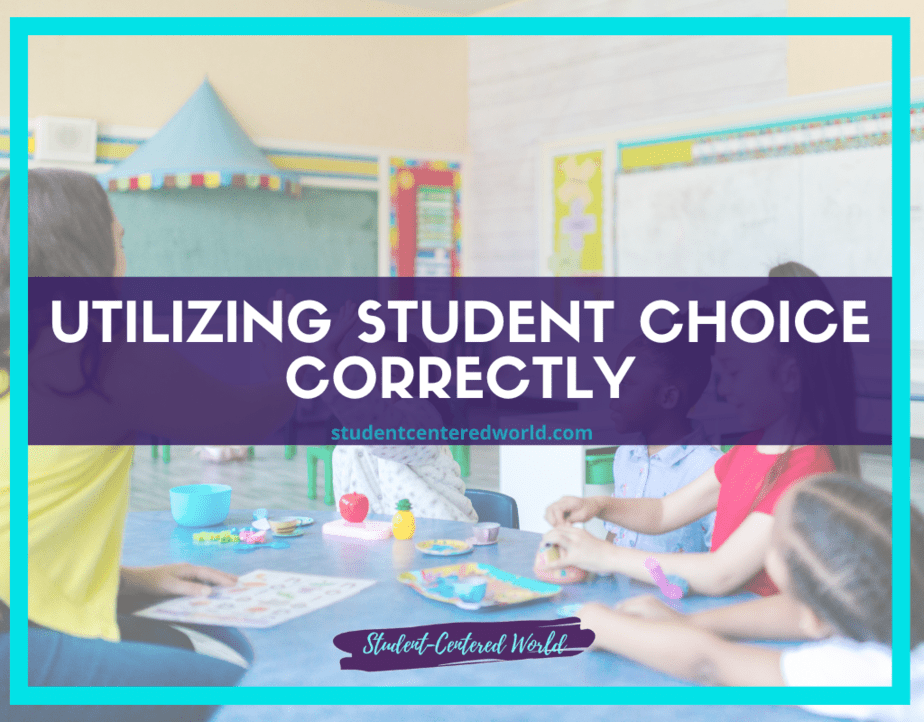Easy Ideas for Student Centered Behavior Management in K-12
One of the scariest parts of a learner-centered environment is coming up with a plan for student-centered behavior management that coincides with the learning process. It’s not difficult, but it seems like it could be overwhelming. If the premise of student-led learning is to have kids up and moving and making noise, how is there any sense of student-centered behavior management? There is a method to the madness, friends…and it works (I promise!)
Just like the largest bottleneck in teaching is often time, the biggest barrier to student-led learning actually comes down to two things: how much stuff you are trying to get done AND what are you doing with your kids during transition times?
It can’t be possible to eliminate disruptive behaviors without the consistent use of direct instruction and a traditional classroom learning environment, right?
That couldn’t be further from the truth. A student-centered classroom is not only consistently engaging students and encouraging lifelong learning, but it looks at critical thinking and the individual student in different ways that allow a student ownership of learning as the center of the learning experience.
You can do all kinds of ‘stuff’ during this time, but unless there is a clearly defined purpose for what you are asking kids to do, your student behavior and management strategies will suffer.
There IS a method to the madness!
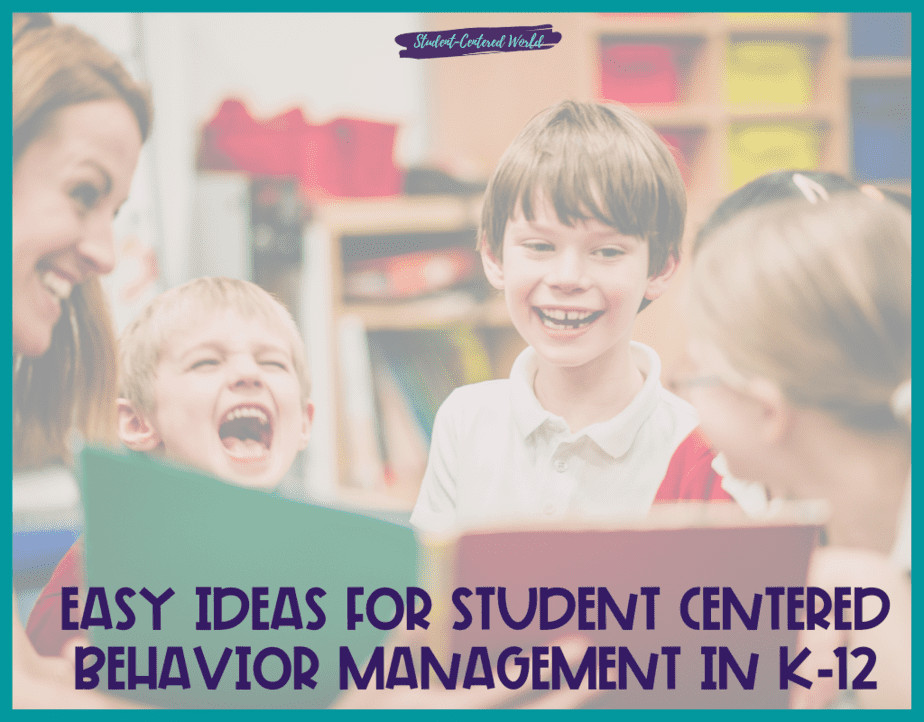
What is student centered behavior management?
Student-centered behavior management is the natural result of giving students responsibility for learning and self-management. Immediately when teachers hear this, they think of complete anarchy and all the reasons why this can’t possibly work.
The only way it doesn’t work is if it isn’t implemented properly. Let me explain:
The traditional way of implementing a behavior plan focuses on consequences as the main means of motivation. If students misbehave, they get detention or lose privileges or some other form of punishment to provide an incentive for them to behave. This is known as management by consequences and it actually creates a difficult challenge for a traditional teacher that often isn’t spoken about.
The trouble with this system lies in the fact that students don’t believe they can control their own behaviors, which is a direct detriment to student motivation. A student doesn’t believe they are in control of their own behaviors if the only way to receive rewards or avoid punishments is by chance or significant other behavior. This is why most students choose not to accept responsibility for misbehavior. They are looking outward instead of inward for motivation (and this is especially detrimental to students with special needs at every grade level, which is something else we don’t usually talk about).
Consequences for Negative Behavior
The second key characteristic of student-centered behavior management is that there are minimal consequences for negative behavior (and there’s a reason for that).
I know that statement is controversial in the world of education, but when students are allowed to be responsible for their own learning without having to rely on chance or external motivation, they will quickly take ownership of their behaviors because they understand that they are in control. And when students accept responsibility for their own behavior, effective managers of behavior, both inside and outside the school environment, will see a reduction in problem behaviors. It helps eliminate the unpredictable outcomes of our students because the change in behavior comes in different forms directly from the hands of the students.
Will there sometimes be outliers that need to be handled? Of course. But that isn’t the focus of student-centered behavior management. Instead, it’s dealt with more on a case-by-case basis in congruence with school discipline policies.
In order for this to work, it is important that adults support students by giving them real-time feedback about their performance. The longer teachers wait to tell students what they are doing wrong or right, the less ownership students feel over their own behavior because it becomes something they have no control over – their performance. This needs to take center stage through a different set of approaches and activities of control.
But the main point of student-centered behavior management is that teachers are not managers of behavior. When students can be responsible for their own learning, they will take responsibility for their own behaviors.
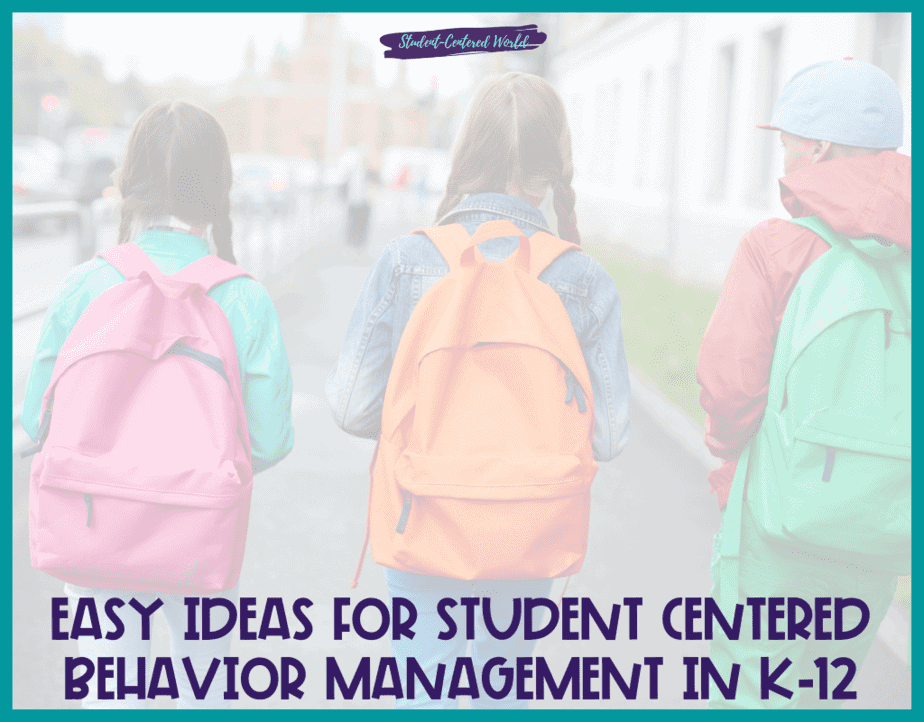
How to Implement a Student Centered Behavior Management Plan
Here are 6 steps to get started with some rockstar classroom management strategies to implement in your student-centered behavior management plan:
1) Stop the use of traditional consequences as a means for behavior management.
Don’t call parents or send students to the office unless it’s absolutely necessary. The point of student-centered behavior management is for students to be responsible for their own learning and behaviors. If you take that responsibility away from them, they will not develop internal motivation. Focus, instead, on goal setting and problem-solving skills in the interests of the students. This will have lasting effects for a long time.
2) Every time a student misbehaves, the first thing to do is stop and redirect.
Ask yourself what is currently happening that is causing the students to act out. Is the activity too hard for them? Do they not know how to behave in this environment? These are especially good questions to ask in middle school when behavior often starts to change a great deal. If the answers to these questions are yes, then make adjustments (see below).
3) STOP lecturing!
Lectures are boring and ineffective, and it will take a lot of practice to get students to sit still while you give them a lecture. Try creating Socratic seminars or implementing project-based learning as a start. Group work also helps teach collaboration if executed properly. There are many effective ways to teach both content and 21st-century skills that k-12 educators often don’t give enough credit or time to because they’re different than how we were taught or how we were taught to teach.
4) Give immediate feedback.
What’s better than delivering information quickly? Nothing! So start giving students instant feedback about their performance. If you are constantly delivering information after the fact, students won’t feel ownership of their behavior. This is key to a functional student-centered behavior management system and one of the main proponents of student success in terms of behavior.
5) Be ready with accommodations for students who struggle significantly with motivation or self-control.
For instance, if you have a student with ADHD who is having difficulty focusing on instruction during class time, it may be helpful to allow that student to stand or walk around during class. You can give a signal for when the student is to be stationary again, and it will help with their focus and attention. In a nonlinear world of high-quality student achievement, sometimes the way learners complete their tasks changes the focus of instruction but results in high-quality learning.
6) Ask yourself if you need to adjust your student-centered behavior management plan.
In most cases, students struggle in school simply because they have been failed by society or lack strong role models at home. The biggest reason why students are not performing up to their potential isn’t because of bad teachers. It’s because they lack the proper support elsewhere or have behavior problems that have been ignored, just labeling them as a “bad kid”. This is a great way to find a student living a self-fulfilling prophesy that they will always have a hard time in school, so why not find the best way to excel in that role. That said, you still need to make adjustments for your environment and then give students a chance to adjust before dealing with the behavior accordingly.
If you keep these six things in mind when creating your student center behavior plan, then it will be much easier to create a management system that students take responsibility for and feel empowered by!
Remember: Student-centeredness goes beyond just rewarding positive behaviors and setting the loftiest educational goals possible. If you only give out points or tokens for good behavior, students will quickly catch on and only behave when you are watching.
It is important for students to feel ownership of their learning and behavior, so it is important to be as student-centered as possible and facilitators of student achievement. Then students will take responsibility for their own learning and behavior and become motivated to perform well because they want to rather than just doing it because they’re required to by their teacher.
Ideas for student centered behavior management
While all this sounds great, most teachers would like some specific ideas for student-centered behavior management that they can put into practice right away.
I have grouped the ideas for student-centered behavior management into three categories:
– Getting students to self-monitor (self, peer, and teacher)
– Designing a system of natural consequences for behavior choices
– Increasing desirable behavior through incentives and external motivators
Before getting into specific ideas it is important to understand the definition of behavior and behavior change.
-A behavior is any purposeful movement, whether large or small, that an individual emits in order to communicate with those around him/her.
Behavior change refers to a change from one type of response (behavior) to another as a result of the application of some form of intervention or treatment.
Getting Students to Self Monitor
As teachers, parents, and carers it is important for us to teach students to become aware of their environment, how they are being perceived by others and then respond in a socially appropriate manner. This basically means helping them learn to monitor their own behavior. If we can help students to become aware of their own behavior and the effect it has on others, we have gone a long way to helping them change their behavior.
In order for students to monitor their own behavior, they must first be taught how.
The following activities can all help students become more conscious of what they are doing and why:
– Role-playing what to do in certain situations (hot seat)
– Watching video footage of themselves (digital cameras are great for this)
– Learning about the effect their behavior has on others (self-awareness)
– Using charts and graphs to monitor student progress through discrete trial training programs.
Self-monitoring can be really effective when combined with natural consequences. Students are able to take more control over themselves and the way they behave.
Designing Natural Consequences
Natural consequences are events that are not artificially imposed on someone, but which naturally follow from their behavior. They happen because of our choices, rather than being forced upon us by some external authority. A natural consequence is something that is likely to happen as a result of a student’s behavior.
This can be positive or negative depending on the choice they make. For example, if they decide to work quietly in class, they are more likely to get their work finished and get it back sooner than if they decide to disrupt others.
When students misbehave there is often an external authority (teacher/parent/carer) who imposes a consequence for them. This is known as having an external locus of control. If you are imposing consequences on your student, you are not allowing them to have control over their own behavior and you are not teaching them anything about the natural consequences that might result from it.
The more independent students become in the way they behave, the more likely it is that there will be natural consequences for their choices.
Natural consequences can often be very effective in helping students learn to take responsibility for their own behavior and how to change it if necessary. They also take away any power that external authority has over students because they are making decisions about their behavior based on their own experiences rather than by what an external force says is best for them.
Increasing Desirable Behavior Through Reinforcers and External Motivation
It has been found that in order to change behavior, in the long term; both positive reinforcement (rewarding desired behaviors) and negative reinforcement (removing undesired behaviors) are necessary.
There is often a misconception that in order to change behavior we only need to focus on negative reinforcement, such as punishment.
In fact, research has shown that although the threat of punishment may make students less likely to misbehave as an immediate reaction (by virtue of their external locus of control), it does not promote long-term change in behavior. This is because the student can choose not to misbehave, while still maintaining their self-esteem and independence.
When students begin to establish control over their own behavior it is important that they are given many opportunities to reinforce this with positive reinforcement (rewarding desired behaviors) so that they feel successful in making good choices for themselves.
This may include giving students choices, allowing them to make decisions, increasing their levels of privacy and independence, rewarding positive behavior with privileges (such as more social time), and making the consequences for misbehavior natural (so that they choose not to act that way).
It has also been shown that students are more likely to be influenced by us when they are in a positive mood, so it is important to be aware of this and try to avoid punishing students during times when they are not likely to respond well.
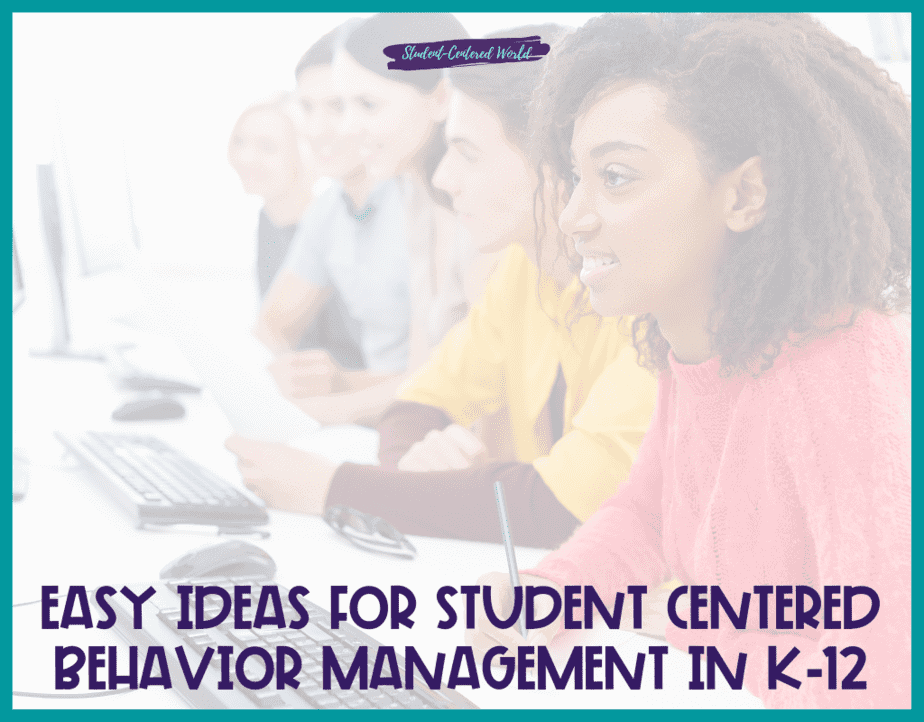
There are many different reinforcers that can be used effectively with students. It is important for teachers, administrators, and parents to provide reinforcement each time the student makes a positive choice, rather than expecting them to learn by only receiving reinforcement every now and again.
Reinforcement needs to be immediate (the student should receive whatever it is that they want or need straight away) and tangible (it needs to give them something that they can physically see). Caregivers also need to ensure that students know exactly why they are receiving reinforcement (i.e., because of something that they did) and what it is for (i.e., “you chose to work quietly on your own”).
These reinforcers can include praise, rewards, privileges, play/social time with other people, access to preferred items of equipment (such as iPads, video games, etc.), and breaks from the educational tasks (such as picking up litter in the classroom).
Student Preference
It is also important to be aware of students’ reinforcer preferences. Some students may prefer to receive tangible reinforcers such as a sticker chart or token economy system instead of praise, for example.
In order to change a student’s behavior in the long term, it is necessary to provide reinforcement for all desirable behaviors and not just specific behaviors that we want the students to learn.
This can often be a challenge in educational settings with students because they work on many different skills at once. In these cases, it may be more feasible to focus on increasing the number of opportunities in which reinforcement is provided, rather than giving reinforcement for every single desired behavior.
It is important to remember that when students are learning new skills they will make many mistakes and it will take a lot of time to see progress. When we take away undesirable behaviors without providing an alternative for the student this can lead to feelings of frustration, low self-esteem, and even aggression.
This is why it is so important for students to have access to appropriate activities that they enjoy doing at all times. This may include the opportunity to play games independently or with other people or engage in any preferred activities such as listening to music, playing a game, etc.
Doing activities of their choice during times when they would typically engage in socially inappropriate behavior can allow them the opportunity to relearn how to behave appropriately and learn new skills at the same time.
These are vital pieces not to be underestimated in terms of a functional student-centered behavior management plan.
Stop Driving the Teacher Struggle Bus
Are you struggling with student engagement, apathy, or keeping your class on track?
💫💫 There’s hope! 💫💫
Join my free teacher workshop “Choosing Choice” and in just 60 minutes, you’ll craft a practical plan to revitalize your teaching. Discover the magic of student choice in boosting engagement, gain quick implementation ideas, and explore strategies for year-long success.
Unlike overwhelming workshops, my approach guides you in real-time, providing more classroom options, reducing stress, and giving you more personal time.
Plus, you’ll earn a 1-hour professional development certificate and have 7 days of access.
Don’t miss this chance to transform your teaching; click below to secure your spot now!



